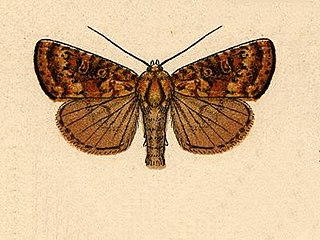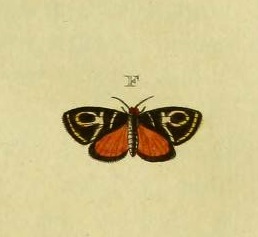
Anacampsis is a worldwide genus of moth with most found in the nearctic and neotropical regions. It is in the family Gelechiidae. The larvae feed on a range of deciduous trees and shrubs in a rolled or folded leaf, or spun shoot.

Aristotelia is a genus of moths in the family Gelechiidae. Well-known species are food plant specialists, and diverse hosts are used – Salicaceae, Solanaceae, Rosaceae, Fagaceae, Fabaceae, Asteraceae.

Gnorimoschema is a genus of moths in the family Gelechiidae.
Euleechia is a genus of tiger moths in the family Erebidae erected by Harrison Gray Dyar Jr. in 1900.

Perigea is a genus of moths of the family Noctuidae. The genus was erected by Achille Guenée in 1852.

Harrison Gray Dyar Jr. was an American entomologist. Dyar's Law, a pattern of geometric progression in the growth of insect parts, is named after him. He was also noted for eccentric pursuits which included digging tunnels under his home. He had a complicated personal life and along with his second wife he adopted the Baháʼí Faith.

Hemerophila is a genus of moths in the family Choreutidae. A number of species was recently transferred to the genus Ornarantia.
Ypsolopha buscki is a moth of the family Ypsolophidae. It is known from the United States, including Arizona.

Ypsolopha is a genus of moths of the family Ypsolophidae. It is the type genus of the family and comprises over 120 described species.
Augustus Busck was a Danish-American entomologist with the United States Department of Agriculture's Bureau of Entomology. He is best known for his work with microlepidoptera, of which he described over 600 species. His collections of Lepidoptera from North America and the Panama Canal Zone are held by the National Museum of Natural History in Washington, D.C.
Andrew Nelson Caudell was an entomologist who specialized in the study of grasshoppers and other insects in the order Orthoptera, becoming a prolific author of taxonomic studies, a member and president of the Entomological Society of Washington, and a fellow of the American Association for the Advancement of Science.
Honora perdubiella is a species of snout moth in the genus Honora. It was described by Harrison Gray Dyar Jr. in 1905. It is found in North America, including Utah, and British Columbia.

Homaledra heptathalama, the exclamation moth or palm leaf housemaker, is a moth in the family Pterolonchidae. It was described by August Busck in 1900. It is found in the United States, where it has been recorded from Alabama, Florida and South Carolina.
Hemerophila diva, the Diva Hemerophila moth, is a moth in the family Choreutidae. It was described by Riley in 1889. It is found in Florida and Cuba.
Donacaula uxorialis is a moth in the family Crambidae. It was described by Harrison Gray Dyar Jr. in 1921. It is found in North America, where it has been recorded from Florida and Texas.

Gelechiinae is a subfamily of moths in the family Gelechiidae. It was described by Henry Tibbats Stainton in 1854.
Gnorimoschema salinaris is a moth in the family Gelechiidae. It was described by August Busck in 1911. It is found in North America, where it has been recorded from Florida, Illinois, Kentucky, Maine, Massachusetts, Michigan and New York.
Psaliodes fervescens is a species of moth in the family Geometridae first described by Harrison Gray Dyar Jr. in 1920. It is found in Central America.

John Bernhardt Smith was an American professor of entomology who specialized in systematics and economic entomology while also serving as the State Entomologist of New Jersey. Smith is remembered in insect taxonomy for the conflict that he had with Harrison Dyar.










